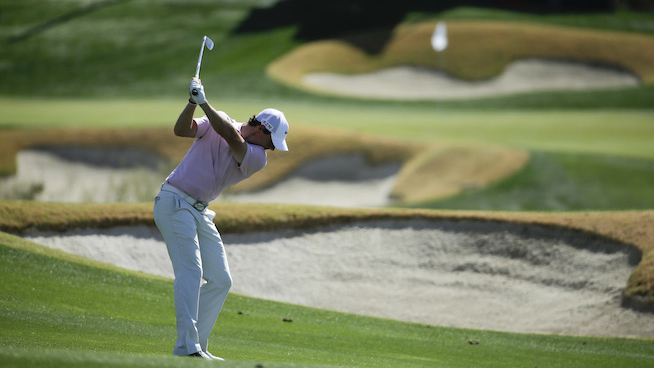Slow Down Your Golf Swing to Get More Distance

AP Images
Do you find yourself swinging your golf club harder and faster in an attempt to improve your distance? Although it seems intuitive that swinging harder and faster should improve distance, slowing down your swing is actually a better strategy. This is because good form contributes to distance just as much as speed. If you swing fast before mastering proper form, you’ll just be performing poor swings faster.
When you strain to hit the ball harder, your arms outpace your body. This prevents you from making good contact with the ball and leads to tense wrists and elbows, which decrease your swing arc and keep you from driving straight through the ball.
Next time you watch the pros, pay attention to their tempo. Many pros have wide, slower-looking swings that still send the ball far. That kind of effortless power comes from years of mastering tempo and form.
Tips for Proper Golf Swing Tempo
1. Practice your slower golf swing without a ball. Visualize and practice the speed you use to toss a ball underhand about 12 yards. That should give you a rough idea of proper swing tempo.
2. Spend a round of golf experimenting with your slower swing. Aim for about 75 percent of your maximum speed. Focus on keeping your elbows and wrists loose to achieve a wider arc, and make sure to finish with a smooth follow-through, keeping your spine vertical. Test your new golf swing with a different club. Slower swings should keep your ball going straight and far, which might mean you need to rethink which club you choose for a given shot.
3. Use the same speed and form with every club. This will give you a better sense of each club’s true range. Also, focus more on keeping your swing fluid than on hitting the ball. If you shift your focus back to hitting the ball, you’re liable to start swinging at 100 percent again. That said, don’t swing too easy—75 percent should still translate to a hard, square shot.
4. The key to correct tempo is consistency. Do not rush your downswing. A full arc should be formed at roughly the same speed. This increases your chances of hitting the ball with the sweet spot of your club and decreases the chance of spin.
Above all, practice. Don’t be discouraged if your first few slow swings are awkward. Any change takes time, but if you stick with it, the results will be worth the investment.
Read More:
[cf]skyword_tracking_tag[/cf]RECOMMENDED FOR YOU
MOST POPULAR
Slow Down Your Golf Swing to Get More Distance

AP Images
Do you find yourself swinging your golf club harder and faster in an attempt to improve your distance? Although it seems intuitive that swinging harder and faster should improve distance, slowing down your swing is actually a better strategy. This is because good form contributes to distance just as much as speed. If you swing fast before mastering proper form, you’ll just be performing poor swings faster.
When you strain to hit the ball harder, your arms outpace your body. This prevents you from making good contact with the ball and leads to tense wrists and elbows, which decrease your swing arc and keep you from driving straight through the ball.
Next time you watch the pros, pay attention to their tempo. Many pros have wide, slower-looking swings that still send the ball far. That kind of effortless power comes from years of mastering tempo and form.
Tips for Proper Golf Swing Tempo
1. Practice your slower golf swing without a ball. Visualize and practice the speed you use to toss a ball underhand about 12 yards. That should give you a rough idea of proper swing tempo.
2. Spend a round of golf experimenting with your slower swing. Aim for about 75 percent of your maximum speed. Focus on keeping your elbows and wrists loose to achieve a wider arc, and make sure to finish with a smooth follow-through, keeping your spine vertical. Test your new golf swing with a different club. Slower swings should keep your ball going straight and far, which might mean you need to rethink which club you choose for a given shot.
3. Use the same speed and form with every club. This will give you a better sense of each club’s true range. Also, focus more on keeping your swing fluid than on hitting the ball. If you shift your focus back to hitting the ball, you’re liable to start swinging at 100 percent again. That said, don’t swing too easy—75 percent should still translate to a hard, square shot.
4. The key to correct tempo is consistency. Do not rush your downswing. A full arc should be formed at roughly the same speed. This increases your chances of hitting the ball with the sweet spot of your club and decreases the chance of spin.
Above all, practice. Don’t be discouraged if your first few slow swings are awkward. Any change takes time, but if you stick with it, the results will be worth the investment.
Read More:
[cf]skyword_tracking_tag[/cf]











